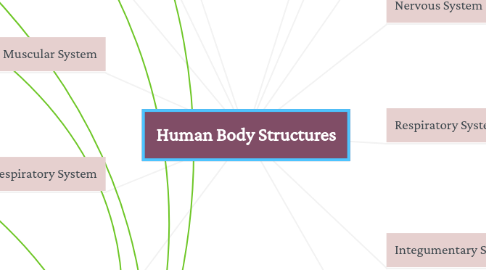Human Body Structures
Anne Bactasaにより

1. Urinary System
1.1. Kidneys Urinary Bladder
1.2. • It produces, stores and eliminates urine that is excreted from the kidneys. Kidneys produces urine through filtering wastes and extra water from the blood.
2. Digestive System
2.1. Stomach Liver Gallbladder Large Intestine Small Intestine
2.2. • It converts food into essential nutrients that is absorbed all throughout the body and helps eliminate unuseful waste.
3. Male Reproductive System
3.1. Epididymis Testes
3.2. • It produces sex hormones as well as gametes it also delivers gametes to female.
4. Muscular System
4.1. Skeletal Muscles Tendons
4.2. • It support movement such as walking, talking, sitting, eating, standing and other daily activities that involves movement.
5. Female Respiratory System
5.1. Mammary Glands Ovaries Uterus
5.2. • It produces sex hormones as well as gametes. • It supports fetus until birth and produces milk for baby.
6. Skeletal System
6.1. Cartilage Bones Joints
6.2. • It provide support for the body. • It protects internal organs from injury, allows movement, produce blood cells and store minerals and nutrients.
7. • The Skeletal and Muscular System are connected because they aid in the movement and strength and energy of the body.
8. • As the food goes through the Digestive System, excess waste and non-essential nutrients as well as waste materials were then filtered out by the Urinary System.
9. • Male and Female Reproductive System are both important to reproduce. Hence, without sex hormones and gametes from either Male or Female Reproductive System would not reproduce an organism.
10. • It is a network of body's organs that get rid of toxins in the body, waste and unwanted materials. • It transport lymph, a fluid containing infection-fighting white blood cells.
11. Endocrine System
11.1. Pituitary Gland Thyroid Gland Adrenal Glands Pancreas Ovaries Testes
11.2. • It selects and removes materials from the blood, processes them and secretes important chemicals and disseminate it in certain parts of the body.
12. Lymphatic System
12.1. Thymus Lymph Nodes Spleen Lymphatic Vessels
13. Nervous System
13.1. Brain Spinal Cord Peripheral Nerves
13.2. • It transmit signals all over the body. • Activates the body's responses.
14. Respiratory System
14.1. Nassal Passages Trachea Lungs
14.2. • It helps the body exchange gases between the air and the blood. • It filters and humidifies the air you breathe.
15. Integumentary System
15.1. Hair Skin Nails
15.2. • It encloses internal body structures. • Protects and cushion the body from infection.
16. Circulatory System
16.1. Heart Blood Vessels
16.2. • It is responsible for blood flow, nutrients, hormones and other gases to and from the cells.
17. • The Integumentary System and Nervous System connects with each other as the Integumentary System protects and covers the brain and nerves from infections.
18. • The Respiratory System and Circulatory System have a relationship as oxygenated blood is needed to be carried out to the body. Nutrients and other gases pass through the Respiratory System and then disseminated by the Circulatory System all over the body.


